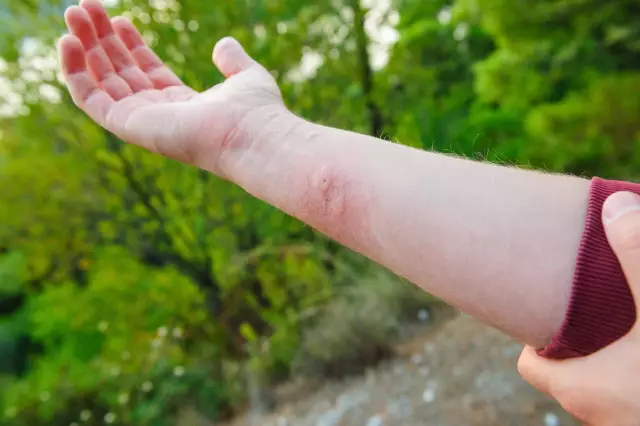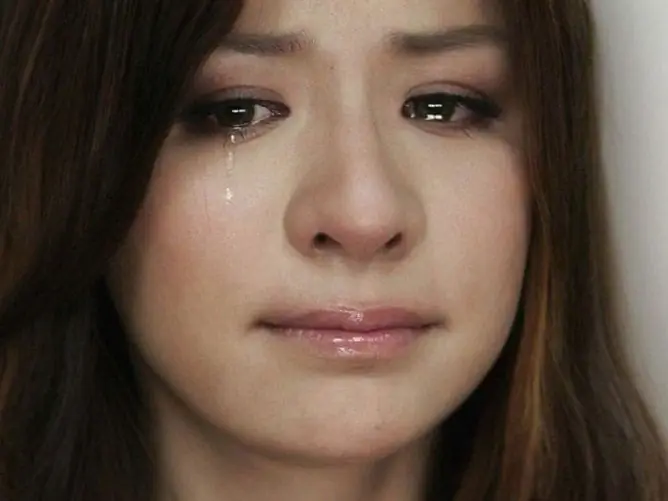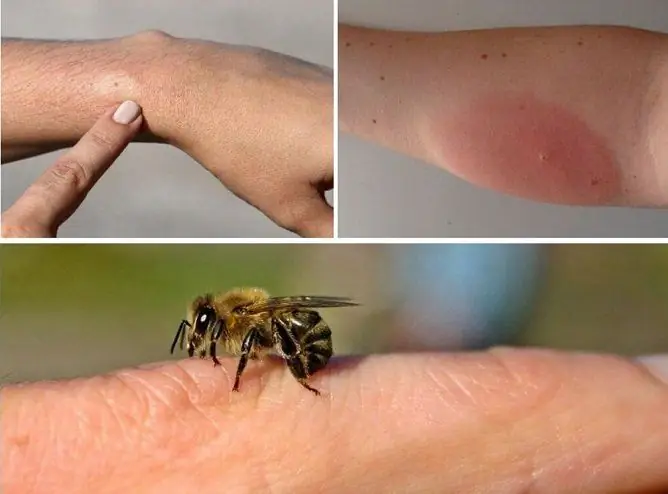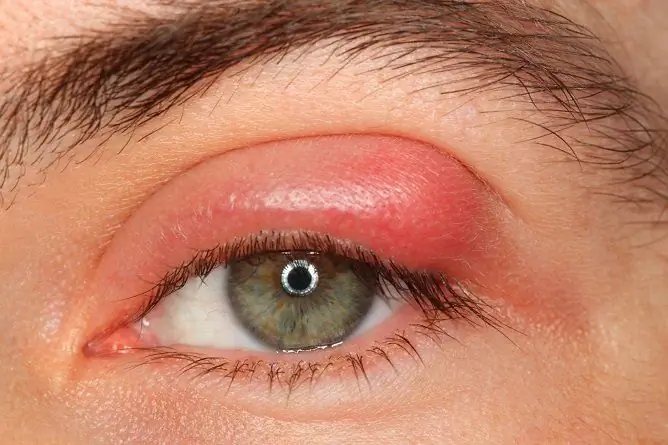- Author Rachel Wainwright [email protected].
- Public 2024-01-15 19:51.
- Last modified 2025-11-02 20:14.
How to relieve swelling from a wasp sting
The content of the article:
- The action of wasp venom
- Symptoms
- First aid for wasp bites
- How to remove swelling from a wasp bite on the second day
- Folk ways
- Prevention
- Video
Every adult should know not only how to relieve swelling from a wasp sting, but also in what cases urgent medical attention is needed. After all, almost every person at least once had the opportunity to experience the sensations that arise when a wasp bites. The poison of this insect causes burning pain and tissue swelling, which can persist from several hours to several days. In some cases, the poison can cause the development of severe allergic reactions, such as anaphylactic shock or Quincke's edema. According to medical statistics, 1-2% of victims die from stinging wasps.

Wasps often sting people, so you need to know how to protect yourself from this and what to do if it does happen.
The action of wasp venom
Wasp venom contains many different biologically active substances. The most important for the human body are the following:
| Name | Mechanism of action |
| Acetylcholine | In large quantities, it blocks the transmission of nerve impulses from nerve endings to muscle cells, as a result of which the latter cannot fully contract |
| Histamine | One of the main mediators of allergy. It is its effect that leads to the appearance of redness of the skin at the site of the lesion, itching, swelling |
| Phospholipases and hyaluronidase | Lead to the destruction of cell membranes, activate the start of the inflammatory process |
| Serotonin | Provokes a strong spasm of small blood vessels in the wound area |
| Mastoparan peptide | Under its influence, there is a rapid and significant increase in the concentration of histamine in the wound area. |
| Neurotoxin | Upon penetration into the bloodstream, it causes a change in the level of blood pressure, provokes the development of an attack of suffocation |
| Hyperglycemic factor | Causes an increase in plasma glucose levels |
Wasp venom in its composition belongs to the category of neuroparalytic poisons. At the time of the sting, a person feels very severe pain, the occurrence of which is associated with the action of serotonin and acetylcholine. It is these biologically active substances that cause a sharp spasm of blood vessels with the development of tissue ischemia (ischemic pain). After a few minutes, the vessels dilate, and the permeability of their walls increases, which leads to the appearance of edema and redness.
When a wasp stings, the human body produces antibodies to wasp poison. With repeated stings, the allergens of the poison come into contact with these antibodies, that is, an antigen-antibody reaction develops. It leads to damage to the membranes of basophils and mast cells, which is accompanied by a significant entry into the bloodstream of serotonin, histamine and other allergy mediators. All this triggers the development of an immediate allergic reaction.
Symptoms
Depending on the amount of injected poison and human resistance to it, there are several variants of clinical manifestations of wasp stings:
| Reaction type | Symptoms |
| Localized (local) reaction | The area of soft tissue at the site of the bite begins to swell and hurt. The diameter of the edema does not exceed 10 cm. There are no general systemic symptoms, and local symptoms persist up to 24 hours. Usually localized reactions are seen in children |
| Light systemic reaction | Edema spreads to tissues distant from the site of the bite. Significantly expressed. This type of reaction is usually observed with multiple bites or bites in the head, neck area |
| Severe systemic reaction (anaphylaxis) |
It develops very quickly, within a few minutes from the moment of the sting. Its symptoms are: • rapidly increasing swelling of the face and neck; • labored breathing; • "blurry" speech; • hyperemia of the skin; • nausea, vomiting; • stomach ache; • impaired consciousness from agitation to coma |
First aid for wasp bites
To minimize pain and swelling after stinging a wasp, you must:
- Examine the bite site. The wasp, unlike the bee, usually does not leave a sting in the wound. But if it remains, then it should be removed using clean tweezers and disinfected in ethyl alcohol. This will prevent further entry of the poison into the body.
- Treat the sting site with a cotton swab abundantly moistened with any disinfectant solution (ethyl alcohol, hydrogen peroxide).
- Apply a piece of ice to the bite. In the absence of ice, you can apply a napkin soaked in cold water. This procedure will reduce pain and stop the swelling from spreading.
- With significant edema, you can give an adult victim one tablet of any antihistamine (Zodak, Tavegil). For children, the dosage is reduced according to age.
- Apply a tourniquet. In case of bites in the arm or leg and the rapid spread of the tumor on the limb, a tourniquet can be applied (hold for no more than 20 minutes). This will slow down the rate at which the poison is absorbed.
- Give a non-steroidal anti-inflammatory drug tablet (only as directed by a doctor).
To reduce the manifestations of intoxication, the victim needs to drink plenty of water (mineral water without gas, fruit drink, compote, warm tea).
Many people who suffer from allergic manifestations always carry special devices for injecting epinephrine or adrenaline with them. If such a device is at hand, then with signs of anaphylaxis, an injection of adrenaline is given with its help.
How to remove swelling from a wasp bite on the second day
With a localized reaction, the day after the bite, the swelling begins to subside, but pain and burning persist. For a faster elimination of these symptoms, the bite site can be lubricated with gel or ointment, which contain antihistamines (Fenistil gel, Moskitol, Psilo-balm).
If the swelling of the tissues persists after 48 hours, then alcohol compresses can be done to dissolve the tumor. To do this, moisten a small cotton napkin with vodka and apply it to the bite site. Cover the top with waxed paper or a piece of cellophane and secure with a warm bandage. How long should the compress be kept? The answer to this question depends on the individual tolerance of the procedure. It should be removed immediately if there is a strong burning sensation.
With severe edema, which is usually observed with systemic reactions to wasp bites, treatment should be carried out as directed by a doctor. The patient may be prescribed antihistamines, anti-inflammatory and diuretic drugs. In some cases, corticosteroid therapy is given in a short course.

With severe edema, medical attention is required
Folk ways
You can also cope with edema after a wasp sting at home using folk methods. Some of them are really quite effective, while others are not only useless, but even dangerous. Consider the most popular recommendations of traditional healers:
- Moxibustion. It is believed that under the influence of high temperature, the poison loses its activity. In fact, this is not the case, attempts to burn the bite site with a lighter flame or a burning cigarette are not effective. In addition, the method is very painful and, in addition, increases the risk of developing further purulent-infectious complications.
- Cutting. Another ineffective and dangerous way. His supporters believe that if an incision is made at the site of the sting, then a significant part of the poison will come out along with the blood. In fact, wasp venom is absorbed almost instantly, and the incision itself is an entrance gate for purulent infection.
- Clay. Applying wet clay to the wound not only does not lead to a decrease in the severity of symptoms, but it can also lead to its infection.
- Alcoholic drinks inside. You can often hear that the victim of a wasp sting should be given 50-100 ml of strong alcohol to drink in order to relieve pain. In fact, alcohol is not an effective pain reliever. In addition, it enhances intoxication.
- Parsley. It has a pronounced anti-edematous and anti-inflammatory effect, therefore it is effective. A bunch of parsley must be rinsed well under running water and scalded with boiling water, chopped with a blender and squeezed out. Rub it into the bite site.
- Bow. Contains substances that have anti-inflammatory and bactericidal effects. The application of onion gruel eliminates pain, reduces swelling and suppresses the activity of the inflammatory process.
Prevention
To prevent a wasp sting, follow these rules:
- Do not walk barefoot on the grass, especially when honey plants such as clover are in bloom.
- Do not pick up fallen fruit from the ground.
- Do not drink beer or sugary drinks from pre-opened cans (a wasp can fly inside and sting strongly at the time of drinking);
- Destroy wasp nests located near your home (it is better to call specialists for this);
- Going into nature, give preference to light-colored clothing (wasps are attracted by bright colors) that cover the body as much as possible.
- In warmer months, try not to use perfumes, eau de toilette and deodorants with obvious fruity and sweet notes.
People who are allergic to wasp stings should always carry the necessary medications with them to stop the anaphylactic reaction. They should discuss with their attending allergist the possibility and feasibility of ASIT therapy.
Video
We offer for viewing a video on the topic of the article.

Elena Minkina Doctor anesthesiologist-resuscitator About the author
Education: graduated from the Tashkent State Medical Institute, specializing in general medicine in 1991. Repeatedly passed refresher courses.
Work experience: anesthesiologist-resuscitator of the city maternity complex, resuscitator of the hemodialysis department.
Found a mistake in the text? Select it and press Ctrl + Enter.






